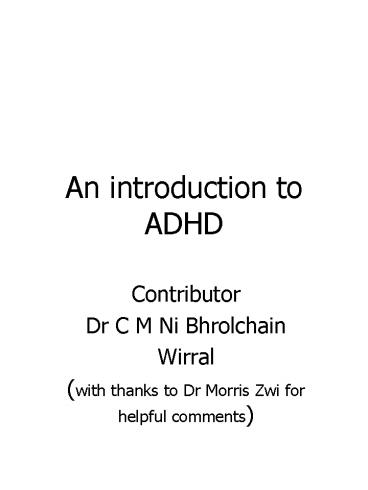An introduction to ADHD - PowerPoint PPT Presentation
1 / 17
Title:
An introduction to ADHD
Description:
1960s Minimal Brain Dysfunction Hyperkinesis / Hyperactivity. 1970s Feingold ... Inattention: easily distracted, fidgety, forgets instructions, flits from task ... – PowerPoint PPT presentation
Number of Views:101
Avg rating:3.0/5.0
Title: An introduction to ADHD
1
An introduction to ADHD
- Contributor
- Dr C M Ni Bhrolchain
- Wirral
- (with thanks to Dr Morris Zwi for helpful
comments)
2
HYPERACTIVITY
- George Still first described
- 1918 Encephalitis Lethargica Brain Damage
- 1960s Minimal Brain Dysfunction
Hyperkinesis / Hyperactivity - 1970s Feingold Exclusion Diet
- 1980s ADHD ADD included
in DSM III) - 1990s Disorders of attention, motor and
perception - (DAMP)
3
A problem is only a problem when it causes a
problem
- Core behaviours in ADHD
- Inattention easily distracted, fidgety, forgets
instructions, flits from task to task, best in
1-to-1 situations - Impulsivity doesnt think
- Overactivity restless, fidgety
4
Other behaviours
- Nags constantly
- Sometimes physically clumsy
- Socially inept
- Disorganised
- Overlaps with learning difficulties d.g. dyslexia
5
Must also be
- Present for at least six months
- Inconsistent with childs developmental level
- Behaviour worse than you would expect from level
of parenting - Clinically significant social, academic or
occupational impairment - Present in 2 or more settings (school, work,
home, surgery)
6
Common confusions (1)
- Normal toddler
- Look at parenting
- Hearing impairment
- Think about it and test
- Specific learning difficulties e.g. dyslexia or
dyspraxia - May co-exist. Consider psychometric testing
- Autism
- May be hyperactive but also other features
7
Common confusions (2)
- Learning disability
- Behaviour may be appropriate to
- developmental age
- Brain injury
- History of coma for 2 weeks
- Conduct disorder
- Basic rights or societal norms
- violated e.g. aggressive to
- people and animals, destroy
- property, deceit or theft
8
Does food cause ADHD?
- Not significantly so
- Usually parents can tell you which food
- Feingold diet helps in only 5 of children if
challenged blind - Diet itself may have placebo effect
9
National recommendations
- Both the Scottish Intercollegiate Guidelines
Network (SIGN) and the National institute for
Clinical Excellence (NICE) have examined ADHD - www.sign.ac.uk
- www.nice.org.uk
10
Main findings
- Diagnosis and initial treatment should be
provided by a psychiatrist or paediatrician with
specialist knowledge of ADHD - Stimulant medication is effective and underused
- Once dose is stable, joint care with GP
11
What will the specialist do? (1)
- Take a detailed history incl development and
behaviour - Consider alternatives and look for specific
features of ADHD - Consider parenting skills
- Collect information from school
- Formal assessment of behaviour by questionnaire
- Formal assessment of IQ if appropriate
12
What will the specialist do? (2)
- Behaviour management should usually be first
option - Consider medication (usually methylphenidate)
- If correct, effect is usually seen within weeks
13
Using medication in ADHD
- The purpose is to treat medically as adjunct to
behavioural management - Medication improves attention span, restlessness,
distractibility - Less effect on social skills etc
14
Medications used
- Methylphenidate
- (Ritalin, Concerta, Equasym)
- Dexamphetamine (Dexedrine)
- Impramine
- (Tofranil)
- Desipramine
- (Pertofran)
- Clonidine
- (Catapres)
- Atomoxetine
- Stimulants
- Other
15
Using stimulants
- Methylphenidate (in all its forms) and
dexamphetamine are controlled drugs and
prescription only medicines - Introduced gradually over a few weeks
- Max dose approx 1mg/kg or 0.5 mg/kg respectively
16
Monitoring
- Monitor appetite and weight
- Measure height regularly
- Monitor BP
- Monitor for psychiatric diagnoses such as
depression
17
Prognosis
- Symptoms were thought to resolve in adolescence
- Now thought that some continue to need treatment
in adulthood - This area needs further study































